Jeremie Averous's Blog, page 117
July 31, 2014
Why You Should Ditch the 10,000 Hours Rule in Favor of the 1,000 or Even 100 Hour Rule
The 10,000 hours rule, popularized by the author Malcolm Gladwell, states that you need 10,000 hours of practice to become a master of anything. Great. That’s an awful lot of time in particular for focused practice.
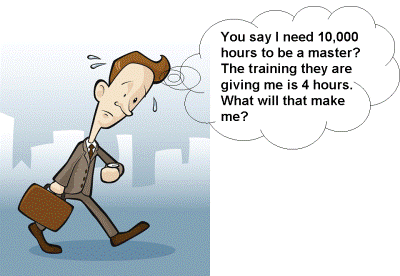 James Altucher notes that “10,000 hours is a lot of time. It’s anywhere from 5-30 years of your life. And then you die. And what do you show for it? That you’re great at watercolor painting. Not everyone is going to be the Beatles. That involves some luck also.” He argues that in reality, 1,000 hours are often enough to reach a sufficient level to be proficient and well above the average. Maybe not a master, but at least a very good practitioner, and among the best in the world at it. And 1,000 hours are much more accessible. It means in particular that it is possible to develop high proficiency in a number of areas, instead of just mastery in a single area.
James Altucher notes that “10,000 hours is a lot of time. It’s anywhere from 5-30 years of your life. And then you die. And what do you show for it? That you’re great at watercolor painting. Not everyone is going to be the Beatles. That involves some luck also.” He argues that in reality, 1,000 hours are often enough to reach a sufficient level to be proficient and well above the average. Maybe not a master, but at least a very good practitioner, and among the best in the world at it. And 1,000 hours are much more accessible. It means in particular that it is possible to develop high proficiency in a number of areas, instead of just mastery in a single area.
Even better, according to him, “In fact, if you get good at learning new things, then you can even take another zero off. The 100 hour rule. Or maybe 200 hours. This makes life a LOT better and more fun. You can take that zero off after you get really good at the first thing. Because then you have learned how to learn. So that saves a lot of energy on the next thing you learn.”
So, let’s start to learn how to learn and have more fun while reaching ‘best in the world’ proficiency in a number of areas!

July 29, 2014
How Success Can’t Happen Without Both Will And Luck
As the saying says, success is due to talent in some part, and also to luck. And great success is just a bit more of talent, and a great chunk of additional luck. We need to recognize that luck is a key ingredient to what we become.
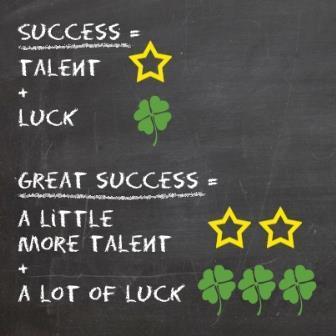 It is tough to accept that our destiny is shaped in a large part by luck. We would like to think that it is just our talent and our efforts – our will. The role of luck stems directly from the complexity of the world around us – and its unpredictability.
It is tough to accept that our destiny is shaped in a large part by luck. We would like to think that it is just our talent and our efforts – our will. The role of luck stems directly from the complexity of the world around us – and its unpredictability.
And indeed there is a large part of modern auto-determination thinking that suggests that you can shape your destiny the way you want. In a certain way, Coaching relies on this assumption by enabling people to act in the direction they choose. Thus, will can shape your destiny, to a certain point.
And will and luck are not independent. On the luck side, there also ways to attract more of it, like for example maintaining a healthy and diverse network that will expose you to more opportunities – something that you do consciously.
The balance between will and luck, how they fight and synergize, is not easy to define. If either ingredient is missing, we won’t reach our expectations. The balance is difficult to find and might depend on the circumstances. In any case, make sure part of your will is devoted to increase your luck!

July 26, 2014
My New Book is Out: Practical Cost Control Handbook for Project Managers
I am very proud to announce that my new book, the Practical Cost Control Handbook for Project Managers, has just been published. It is not a all-publics book like the previous ones, still it results from significant effort and continuous improvements in the past 3 years. It is the public version of a book that has been already produced as an internal handbook for a few clients, selling more than 1,000 copies already of previous versions.
 It is available worldwide through all online bookshops, and is also available as a Kindle version! Here are the links to Amazon.com for the paperback version and for the Kindle version.
It is available worldwide through all online bookshops, and is also available as a Kindle version! Here are the links to Amazon.com for the paperback version and for the Kindle version.
This must-have practical handbook for Large, Complex Projects originated in the trenches of actual project execution.
It is not a heavy and detailed bible, but rather a practical reference for project practitioners to understand the principles and traps of Cost Control and Forecasting and be able to raise the right challenges to their teams.
Proper Cost Control and Forecasting must support the Project Manager’s decision making; unfortunately, that is still rarely the case. This handbook explains how to better implement these key processes, thereby improving significantly the odds of maintaining projects under control and taking the right decisions at the right time.
If you are interested, here is an exclusive link to the table of contents and index and to the foreword and introduction.
For those keen on project management, I will publish two more books in the next 12 months or so: a book about project risk management, and a book about schedule management in large projects.

July 24, 2014
How the Conventional Organization too Often Crushes True Prioritization
Further to our post on “How to Truly Prioritize: a Vital Skill for Success“, I would like to mention how I observe that most organizations seem to be creating a Brownian movement that leads us in the opposite direction from correct prioritization (i.e., stop doing what is not a priority).
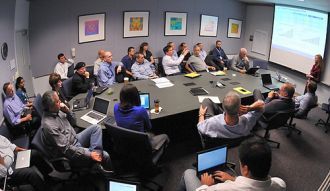
Meetings – one of worst killers of quality time spent on real priorities
Meetings too often suck out time from real productive work on priority issues and are often unproductive
Other people constantly come with new issues and topics that add up on our list of to-do actions with no true priority ranking (or, worse, too many use a priority based on the rank of the originator multiplied by the implied urgency)
Emails and other interruptions caused by our modern communication tools pollute the time we could spend concentrating of priority (thus, hard) work
etc.
Ask yourselves how much time you really spend on what you have identified as your top priorities for the year. Got it? Really? Research has shown that the time you think you spent on these actions in reality was probably one half or one third of what you think, if an independent observer was really looking at what you are spending your time on!
Fight the natural trend of organizations to create movement for the sake of justifying their existence. Priorities once defined should occupy a significant chunk of your time. That’s the only way to be really effective. A good way is to define spans of time out of the usual operational emergencies to make sure to make good progress on what is really important. Are you ready for it?

July 22, 2014
How to Truly Prioritize: a Vital Skill for Success
In my coaching, training and consulting activities, I encounter again and again the same phenomenon: people say they prioritize – but in effect they don’t. And those who really do are those that rise to be successful.
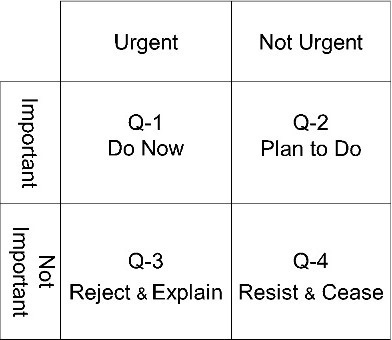
stop doing what is not important (even if looks urgent!)
What is true prioritization? To put it simply, it is not to do what is not deemed to be a priority. That sounds simple but that is where most of us fail.
Everybody can run some kind of prioritization scheme and decide that some actions are indeed, priority actions. But when it comes to stopping to do the rest, that is where people stall. Objections abound, caused by our fear of being threatened by unexpected events. For example, lately I was giving a course on project risk management; and when I came to saying that people should drop any action that was not in the top-10 priority list and merely monitor those risks, all sorts of excuses were given. Of course, a risk might materialize that was not in the priority list, but does that mean that we should not focus our attention and limited action capability to truly critical actions? If the risk is not in the priority list, it is less important and less essential (by definition), compared to those that are really critical!
It’s tough but necessary: true prioritization is about not doing what is not deemed a priority. You can monitor these things, but focused action will be much more effective than spreading your time and attention chasing too many things at the same time. Prioritize truly and multiply your impact on the world by easily a factor of 5 to 10!

July 19, 2014
How Nature Always Reminds Us That Rare, Short Catastrophic Events Shape the World
In many natural science domains, we increasingly become conscious that in nature, 95%+ of the change we observe comes from short and intense phenomena such as storms, floods, earthquakes.
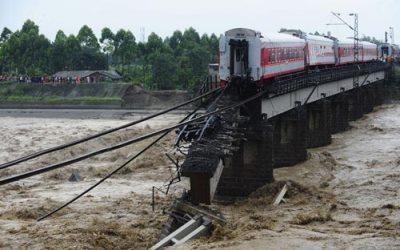 For example in the study of erosion, rivers shapes and material that is then transported by rivers such as boulders, it is very clear that rare storms and floods are the main contributors to the shaping of the riverbed (and sometimes, to the destruction of some man-made structures that tempted to tame it). While most textbooks still present erosion as the continuous work of air and water over millenniums, in reality, most of the work has been done during much shorter periods -days- of intense flow.
For example in the study of erosion, rivers shapes and material that is then transported by rivers such as boulders, it is very clear that rare storms and floods are the main contributors to the shaping of the riverbed (and sometimes, to the destruction of some man-made structures that tempted to tame it). While most textbooks still present erosion as the continuous work of air and water over millenniums, in reality, most of the work has been done during much shorter periods -days- of intense flow.
It does similarly happen in the world that surrounds us. Most of the changes come from unpredictable, short and intense moments, which we often call crisis (or also, in the field of society, revolutions). Crisis create the conditions for re-shaping our society, our economy, our organizations. Our duty is to protect ourselves and our loves ones against those crisis, and also to take advantage of them when they happen – because ultimately it is those rare events that shape our environment.

July 17, 2014
How Our Energy Goes Where Our Intention Goes
I had lately a great Tai Chi introductory session, where I had a live experience that where our intention goes, so goes your energy.
 It was a simple experience of trying to resist a partner bending my arm. Without any particular instruction, that prove possible (with some exertion). With the instruction of focusing on trying at the same time to reach with one’s arm a distant point (intention), it proved impossible for the partner. In this simple experiment, nothing else had changed (in particular, not the strength of the partner).
It was a simple experience of trying to resist a partner bending my arm. Without any particular instruction, that prove possible (with some exertion). With the instruction of focusing on trying at the same time to reach with one’s arm a distant point (intention), it proved impossible for the partner. In this simple experiment, nothing else had changed (in particular, not the strength of the partner).
This simple experience shows the power of our intention on what we can achieve. Where we have a very strong intention on a (not too) distant purpose, we can just be really invincible. Our focus overcomes all efforts to resist. Nothing can bend us anymore.
Let’s be clear on our intention, and with our focus, we won’t be influenced any more by external forces. Our energy will flow towards our intent.

July 15, 2014
Why Innovation is about Creating Effective Conversations
Hugh McLeod writes in a post: “If your company isn’t innovating, it’s likely because no one is facilitating the right conversations”
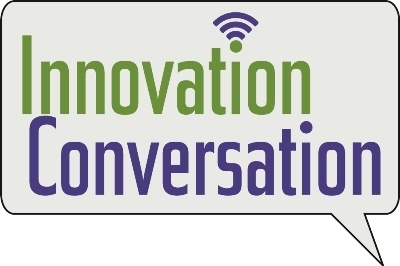 Further he writes, “In Gapingvoid’s long experience working with Fortune 500 companies, we’ve found they all have the same problem. When communication shuts down, so does innovation. And it isn’t lack of money, talent or resources. What’s missing is the interpersonal. They either don’t like each other or don’t like talking to each other or both.”
Further he writes, “In Gapingvoid’s long experience working with Fortune 500 companies, we’ve found they all have the same problem. When communication shuts down, so does innovation. And it isn’t lack of money, talent or resources. What’s missing is the interpersonal. They either don’t like each other or don’t like talking to each other or both.”
Ideas are generating by the encounter and the mix with other ideas (see for example our post ‘Idea Multiplication‘). Innovative companies must have the right conversations to foster innovation. This often needs to be facilitated – either simply through the architecture (creating places to foster encounters) or through facilitation. It takes some effort to create meaningful, powerful conversations – and they are so needed in most organizations!
Create powerful conversations, and you will create innovation. So simple!

July 12, 2014
Watch the video and slides of my May 2014 talk at Lycee Hoche (in French)
Did you miss it? The video and the slides of my speech at the Lycee Hoche in Versailles (France) are now available (in French).
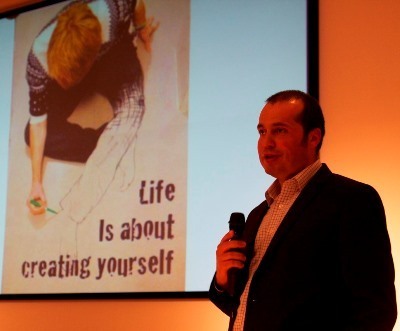 The topic of this speech at my former high school was about my career – and I couldn’t help add something about the Fourth Revolution as well. It is a good introduction to the Fourth Revolution in French.
The topic of this speech at my former high school was about my career – and I couldn’t help add something about the Fourth Revolution as well. It is a good introduction to the Fourth Revolution in French.
When is comes to presenting my career, it is an exercise that I don’t do too often and it was kind of funny to see how in hindsight a lot of what I have done and the choices I made, make an awful sense. In particular, my leaning towards project-based environments, and my international career. While these choices were at the time probably mostly driven by curiosity, luck and serendipity, they seem now to wave into a coherent framework. It is also probably because in the process I forgot quite a lot about other stuff that did not work out!
Watch the talk on Youtube here (if you can’t see the video, here is the link)
The segment on the Fourth Revolution starts here.
Jeremie Averous speaking at Lycee Hoche, May 2014 (Presentation au Lycee Hoche, Mai 2014) from Jeremie Averous
Happy viewing!

July 10, 2014
Why Giving the Right Impulse at the Right Moment is More Effective than Continuous Effort
When it comes to achieving results, it is more important to put the right effort at the right moment than to row continuously up to exhaustion.
 That is what I learnt when I was lucky enough a few weeks ago to experience rafting in the Alps mountains. How does that work? You let yourself flow down a torrential river on some air filled rubber raft. As a beginner, you have to follow the orders of an experienced helmsman.
That is what I learnt when I was lucky enough a few weeks ago to experience rafting in the Alps mountains. How does that work? You let yourself flow down a torrential river on some air filled rubber raft. As a beginner, you have to follow the orders of an experienced helmsman.
The way it worked was very instructive: most of the time we just let ourselves be taken by the flow (which was a very pleasurable moment); only at determined moments was decisive effort required to maneuver in rapids, in a concerted and quick effort. And even when it came to avoid an obstacle, the point was to strike an effective compromise between effort and letting oneself be pushed by the flow. And all in all, it was more effective to row powerfully at short, decisive moments, than try to row hard all along.
This event was a teambuilding with a client, and as such this was a great learning point for all sorts of organizational change: the point is not to try to try to constantly try to go against the flow, nor to exhaust oneself trying to resist the force of the organization’s natural evolution. The point is to identify the short moments of intense effort that are sufficient to bring the boat to the chosen safe trajectory. It is about knowing that you need to let go most of the time except well chosen, intense moments. Great learning!




